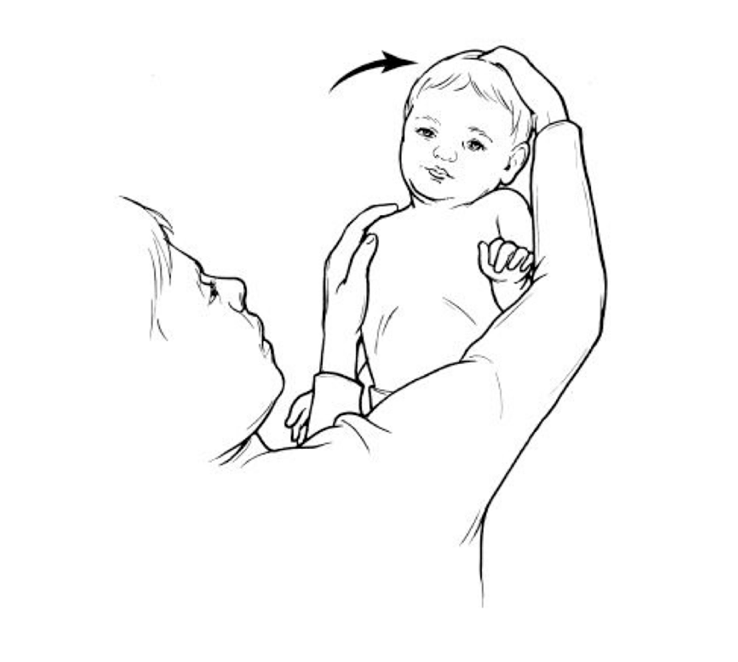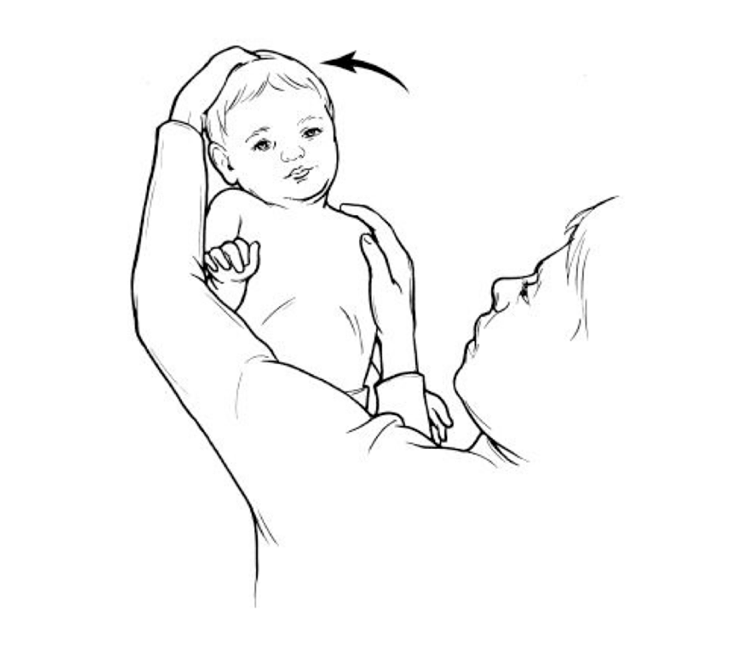Torticollis is a “twisting” of the neck caused by tightness in the neck muscles. A child with torticollis presents with his or her head tilted towards one side, while the chin is turned in the opposite direction. Typically children with torticollis also present with a limited range of motion in their necks.
A well-rounded approach to treatment is beneficial for a child with torticollis. They are able to improve neck motion and position, meet developmental milestones on time, and parents are able to understand how to care for their child.
The focus of treatment is on stretching, specifically side bending and rotation, and positioning.

Stretching – Side Bending
Right Torticollis
Baby Position: lying on back on the floor
Parent Hand Position:
- Place right hand on top of the right side of baby’s head
- Hold child’s right shoulder down with left hand
- Slowly bend baby’s left ear towards the left shoulder
Hold the position for 30 seconds, or as tolerated by the baby
Repeat 2-4 times, 3-4 times a day

Left Torticollis
Baby Position: lying on back on the floor
Parent Hand Position:
- Place left hand on top of the left side of baby’s head
- Hold child’s left shoulder down with right hand
- Slowly bend baby’s right ear towards the right shoulder
Hold the position for 30 seconds, or as tolerated by the baby
Repeat 2-4 times, 3-4 times a day

Stretching – Rotation
Right Torticollis
Baby Position: lying on back on the floor
Parent Hand Position:
- Place left hand on baby’s left shoulder
- Cup baby’s head with the right hand
- Use left hand to hold baby’s chin
- Slowly turn baby’s nose to the right shoulder
Hold the position for 30 seconds, or as tolerated by the baby
Repeat 2-4 times, 3-4 times a day.

Left Torticollis
Baby Position: lying on back on the floor
Parent Hand Position:
- Place right hand on baby’s right shoulder
- Cup baby’s head with the left hand
- Use right hand to hold baby’s chin
- Slowly turn baby’s nose to left shoulder
Hold the position for 30 seconds, or as tolerated by the baby
Repeat 2-4 times, 3-4 times a day.

Positioning
“Football” Carry: hold baby facing away from you, side-lying position
- Right Torticollis – baby’s right ear resting against parent’s right forearm
- Left Torticollis – baby’s left ear resting against parent’s right forearm
Position forearm between the baby’s ear and shoulder to facilitate stretching of the neck
Parent’s other arm between the baby’s legs, supporting the baby’s body.
Floor Time – Side-Lying
Baby Position: lying on side on the floor
- Right Torticollis – place baby on left side
- Left Torticollis – place baby on right side
Allows for gravity to help stretch the baby’s neck muscles
Floor Time – Lying on Stomach
Baby Position: lying on stomach on the floor
- Right Torticollis – place toys to the right side to encourage turning head to the right
- Left Torticollis – place toys to the left side to encourage turning head to the left
Other Tips
Right Torticollis
- Position baby across the shoulder to face right
- Breastfeeding or bottle-feeding, position baby to face right
- Position baby in the crib to encourage to look right towards activities in the room
- Hold toys up, out, and to the right to encourage baby to turn head to the right
Left Torticollis
- Position baby across the shoulder to face left
- Breastfeeding or bottle-feeding, position baby to face left
- Position baby in the crib to encourage to look left towards activities in the room
- Hold toys up, out, and to the left to encourage baby to turn head to the left
Does your baby show signs of Torticollis? Are you having difficulty helping your baby stretch or provide opportunities for floor time? Book your free consultation today! Our physical therapists are available to provide guidance and support.
*Graphics
Positioning for Play: Interactive Activities to Enhance Movement and Sensory Exploration
By Allison Whiteside and Rachel B. Diamant

